Groundbreaking new national standard guides employers on how to prevent workers from being struck by falling objects
The International Safety Equipment Association (ISEA) and American National Standards Institute (ANSI) have developed a first-in-the-industry standard aimed at helping employers reduce the risk of dropped objects incidents in industrial and occupational settings. ANSI/ISEA 121-2018, American National Standard for Dropped Object Prevention Solutions — approved on July 2, 2018 — establishes minimum design, performance, and labeling requirements for solutions and testing that mitigate this hazard.
“Every death in the workplace is a tragedy, and ISEA is dedicated to helping industries and employers protect their workers from being injured or killed by falling objects,” said Nate Bohmbach, Associate Product Director, Ergodyne and Chair of ISEA’s Dropped Object Prevention Group.
The standard comes in response to the thousands of workers each year in the U.S. who are injured — and the hundreds who die — from being struck by a falling object, such as hand tools, instrumentation, small parts, structural components and other items that have to be transferred and used at heights. In 2016, the Bureau of Labor Statistics reports there were 255 fatalities and 47,920 reported injuries from dropped objects in the United States, making this the third leading cause of injuries on the jobsite, according to OSHA. Compared to 2015, deaths from dropped objects were up approximately 3.24 percent, and injuries increased by 6.85 percent.
Overall struck-by injuries were up 8.7 percent from 2013 to 2014, and are projected to increase to 9.1 percent by the end of 2018, according to the Bureau of Labor Statistics. Liberty Mutual Insurance alone said it paid out $5.3 billion in workers compensation claims from 2013 to 2014. Workers comp claims don’t include damage to equipment, structures and the environment.
“The Dropped Object Prevention Group has worked countless hours to help save lives by creating this groundbreaking new standard. We developed it from scratch — it’s not a revision of anything — and that makes it particularly significant,” explained Bohmbach. “The standard kicks off a new generation of tethering practices. A lot of people are tethering their tools and equipment using just duct tape and rope, which is pretty alarming, so this standard guides employers and workers toward safer, more reliable solutions.”
ISEA took the lead in responding to this little-known hazard by forming the Dropped Object Prevention Group — including leading safety equipment manufacturers, such as Ergodyne, 3M Safety, Guardian Fall Protection, Hammerhead Industries, Radians, Ty-Flot, and West Coast Corporation — to standardize the solutions available to protect workers from objects falling from heights.
“Eliminating the risk of injuries is an important part of any safety program. We are proud to have developed a standard that will play a part in keeping workers safer,” said Cristine Fargo, ISEA Director of Member and Technical Services.
Industries where elevated work areas are common have been especially susceptible to the risk of dropped objects, including the oil and gas, construction, energy and telecommunications infrastructure, shipping operations and aviation industries.
“By establishing manufacturing guidelines for tethering systems, the ANSI/ISEA 121-2018, is a significant first step in reducing dropped tool incidents,” said John Salentine, Vice President, Sales & Marketing, Hammerhead Industries, Gear Keeper Products and member of ISEA’s Dropped Object Prevention Group. “The standard establishes minimum design, performance, and labeling requirements that can mitigate this hazard. Users can feel confident that the ANSI/ISEA compatible tool tethering systems they choose have met these guidelines. This is extremely important because ANSI/ISEA 121 tethering systems include many components (i.e. tool attachments, lanyards, carabiners and anchor points) that will work safely together even when purchased from different manufacturers. ANSI/ISEA 121 provides recommendations and information to help employers understand how to match tethers with tool attachments and anchor points for a safer work environment and help minimize the risk of dropped object incidents. ISEA will look to develop additional resources to help employers minimize the risk of dropped object incidents.”
The standard addresses four active controls, but does not include passive controls. The active controls are:
- Anchor attachments
- Tool attachments
- Tool tethers
- Containers (buckets, pouches)
“ANSI/ISEA 121-2018 gives manufacturers guidelines, and establishes minimum design, testing and performance criteria,” explained Matt Thoms, Designer/Drafter, 3M and member of ISEA’s Dropped Object Prevention Group. “Clearly, a variety of industries should be using safety products that will help keep tools and other items from falling off workers and equipment at heights.”
Copies of the standard can be purchased online from ISEA and from ANSI’s licensed resellers.
View the ISEA Dropped Objects Prevention Solutions Resource page: [button url=”https://isea.wpengine.com/dropped-object-prevention-resources/” color=”blue”]Click Here[/button]

